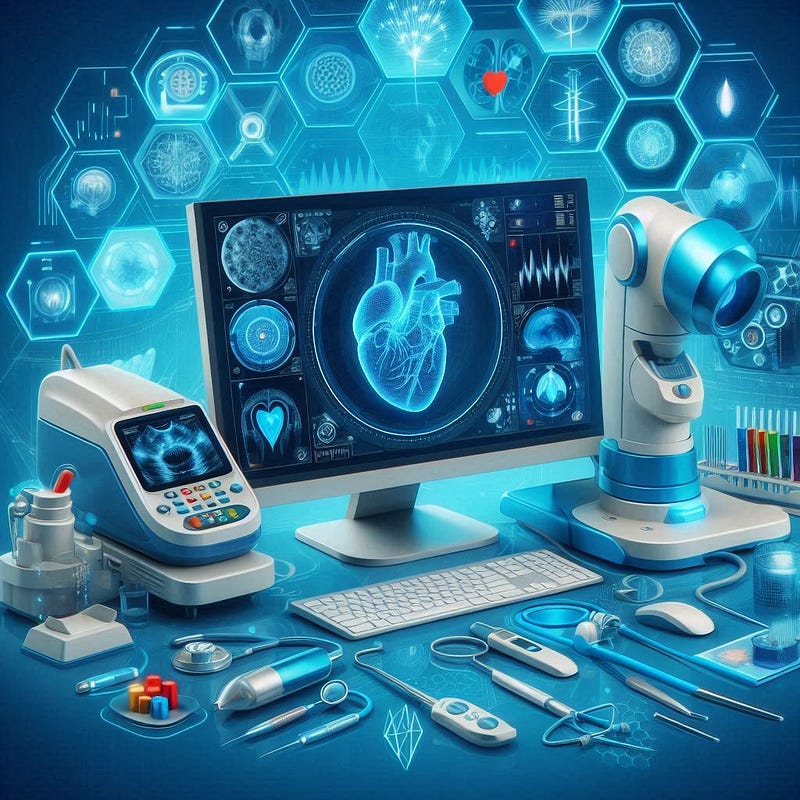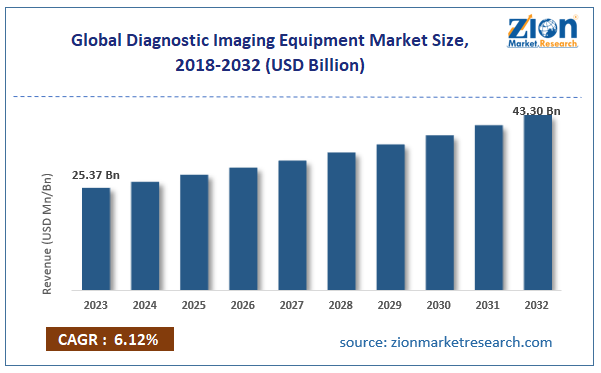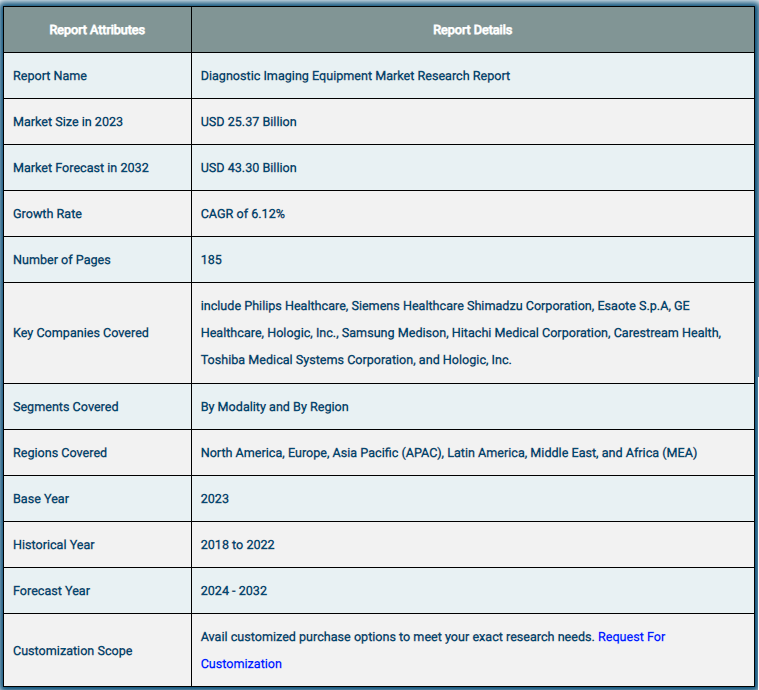Diagnostic Imaging Equipment Market Size, Share, Growth, Trend, Report 2032

The global market for diagnostic imaging equipment was estimated to be worth USD 25.37 billion in 2023 and is expected to grow to USD 43.30 billion by the end of 2032, according to a report released by Zion Market Research. Over the course of the projection period, the market is anticipated to rise at a CAGR of 6.12%. The growth factors, barriers, and effects on demand for the global diagnostic imaging equipment market are examined in this study for the period of forecasting. Additionally, it will support exploration and navigation of the emerging prospects in the Diagnostic Imaging Equipment Market sector.
✈👉Get a Free Sample: 🚀https://www.zionmarketresearch.com/sample/diagnostic-imaging-equipment-market
Introduction:
- Overview of Diagnostic Imaging Equipment:
Introduce diagnostic imaging equipment as vital tools used in the medical field to visualize the internal structures of the body, aiding in the diagnosis and monitoring of various health conditions. Common modalities include X-ray, MRI, CT scans, ultrasound, and nuclear medicine. - Importance of the Market:
Highlight the significance of the diagnostic imaging market in enhancing diagnostic accuracy, improving patient outcomes, and reducing healthcare costs. Discuss the increasing reliance on imaging techniques for early disease detection and management.

Overview of the Global Market for Diagnostic Imaging Equipment
Medical imaging is another term for diagnostic imaging. In essence, diagnostic imaging is the technique of employing electromagnetic radiation to take an accurate picture of a patient’s inside anatomy. Radiation is used in diagnostic imaging to identify and treat disorders. Medical imaging encompasses a range of modalities, the most often used of which being CT scans and MRI machines.
Market Segmentation for Diagnostic Imaging Equipment Worldwide
The market for diagnostic imaging equipment is divided into regions and modalities on a global scale. The global market is divided into segments based on the modality, including nuclear imaging systems, mammography systems, computed tomography (CT) scanners, MRI systems, ultrasound systems, and X-ray imaging systems. The markets for diagnostic imaging equipment are divided geographically into North America, Europe, Asia-Pacific, and the Rest of the World.
Growth Factors for the Global Diagnostic Imaging Equipment Market
Growing interest in medical imaging equipment among researchers and technological developments in diagnostic imaging equipment, such as upright MRIs and handheld X-ray machines, are the main factors propelling the market for diagnostic imaging equipment. Other factors driving the market expansion include the growing number of elderly people and the government’s increased spending in the development of medical imaging technology.
The need for diagnostic imaging equipment has increased recently as a result of people’ increased awareness of ailments, their diagnosis, and available treatments. Furthermore, the modern population’s bad diet and lifestyle choices make them more susceptible to disease, which raises the risk of gastrointestinal problems, cancer, heart disease, and other genetic abnormalities. Diagnostic imaging equipment is necessary for both the diagnosis and treatment of various illnesses, which is driving market expansion. The high cost of the equipment and the harmful effects of radiation are the elements that will have a negative impact on the market for diagnostic equipment.
✈👉Directly Purchase a copy of the report with TOC: 🚀https://www.zionmarketresearch.com/toc/diagnostic-imaging-equipment-market
Market Analysis of Diagnostic Imaging Equipment: Report Extent

Regional Analysis of the Global Diagnostic Imaging Equipment Market
North America is the region that has contributed the most to the market for diagnostic imaging equipment in terms of revenue. Advanced technology like mobile, 3D, and 4D scanners are highly sought after for the early detection of diseases including cancer and cardiovascular disorders. However, the Asia Pacific area is where the market for diagnostic imaging equipment is expanding at the fastest rate. Growing public and professional knowledge of health issues, an increase in the number of older persons with weakened immune systems, an increase in government spending, and bettering reimbursement practices are all factors driving this expansion.
Market Drivers:
- Rising Prevalence of Chronic Diseases:
The increasing incidence of chronic diseases such as cancer, cardiovascular diseases, and neurological disorders is driving the demand for diagnostic imaging equipment. - Technological Advancements:
Innovations in imaging technologies, such as the development of portable imaging devices and advancements in imaging techniques (e.g., 3D imaging), are enhancing diagnostic capabilities. - Growing Aging Population:
An aging population that is more susceptible to various health conditions increases the demand for diagnostic imaging services and equipment. - Increasing Healthcare Expenditure:
Rising healthcare investments, particularly in emerging economies, are facilitating the acquisition of advanced diagnostic imaging equipment.
Market Restraints:
- High Cost of Equipment:
The significant capital investment required for purchasing advanced imaging equipment can be a barrier for smaller healthcare facilities. - Regulatory Challenges:
Navigating the complex regulatory landscape for the approval of diagnostic imaging equipment can slow down market growth. - Lack of Trained Professionals:
A shortage of skilled professionals to operate advanced imaging equipment and interpret results may limit their effective utilization.
Market Segmentation:
- By Equipment Type:
- X-ray Systems: Traditional imaging technology widely used for various applications.
- Computed Tomography (CT) Scanners: Advanced imaging equipment providing detailed cross-sectional images.
- Magnetic Resonance Imaging (MRI) Machines: Non-invasive imaging technique for visualizing soft tissues.
- Ultrasound Equipment: Uses sound waves to produce images of internal body structures.
- Nuclear Imaging Equipment: Includes PET and SPECT scans used for functional imaging.
- By Application:
- Oncology: Increasing demand for imaging services to diagnose and monitor cancer.
- Cardiology: Utilization of imaging techniques for assessing cardiovascular conditions.
- Neurology: Imaging services for diagnosing neurological disorders.
- Orthopedics: Applications in diagnosing musculoskeletal conditions.
- By End-User:
- Hospitals: The largest end-user segment requiring diagnostic imaging for patient management.
- Diagnostic Imaging Centers: Specialized facilities offering imaging services.
- Research Institutions: Facilities conducting research and clinical trials requiring imaging equipment.
Regional Insights:
- North America:
The largest market for diagnostic imaging equipment, driven by advanced healthcare infrastructure, high prevalence of chronic diseases, and significant investments in research and development. - Europe:
A significant market characterized by increasing healthcare expenditure and technological advancements. Countries like Germany and the U.K. are leading in market growth. - Asia-Pacific:
The fastest-growing region, propelled by rising healthcare investments, increasing patient populations, and growing awareness of advanced diagnostic technologies. Countries like China and India are witnessing rapid advancements in diagnostic imaging. - Rest of the World (RoW):
Analyze market dynamics in regions like Latin America, the Middle East, and Africa, where improving healthcare infrastructure is fostering the growth of diagnostic imaging equipment.
Competitive Landscape:
- Key Players:
Discuss leading companies in the diagnostic imaging equipment market, such as Siemens Healthineers, GE Healthcare, Philips Healthcare, and others. Highlight their product offerings, market strategies, and recent developments. - Technological Innovations and Collaborations:
Emphasize recent advancements, product launches, and partnerships that enhance the capabilities of diagnostic imaging equipment.
Future Outlook and Trends:
- Integration of Artificial Intelligence:
The incorporation of AI and machine learning in diagnostic imaging will enhance image analysis, improve diagnostic accuracy, and streamline workflows. - Rise of Point-of-Care Imaging:
Increasing demand for point-of-care imaging solutions will drive the development of portable and user-friendly imaging devices. - Growth of Telemedicine:
The rise of telemedicine will facilitate remote consultations and imaging services, improving accessibility for patients. - Focus on Preventive Healthcare:
Growing emphasis on preventive healthcare will drive demand for diagnostic imaging services for early disease detection.
Conclusion:
Summarize the key trends and growth opportunities in the diagnostic imaging equipment market, emphasizing drivers such as technological advancements, rising prevalence of chronic diseases, and increasing healthcare expenditure. Highlight the potential for growth in emerging markets and the importance of addressing challenges related to costs and skill shortages.
✈👉Enquiry for buying: 🚀https://www.zionmarketresearch.com/inquiry/diagnostic-imaging-equipment-market
Browse other trend reports:
Surface Cleaning Products Market
Contact Us:
Zion Market Research212
USA/Canada Toll Free: 1 (855) 465–4651
Newark: 1 (302) 444–016611\
Web: https://www.zionmarketresearch.com/
Blog: https://zmrblog.com/
Comments
Post a Comment